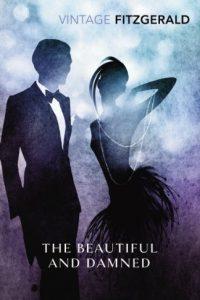“In 1913, when Anthony Patch was twenty-five, two years were already gone since irony, the Holy Ghost of this later day, had, theoretically at least, descended upon him.”
Idleness, indulgence, and indolence.
The Beautiful and Damned was F. Scott Fitzgerald’s second novel. Originally published in 1922, it was almost a failure in comparison to his best-selling This Side of Paradise. It’s a profoundly pessimistic novel portraying the dark side of the Jazz Age.
It’s a tale of morality and decadence in true Fitzgerald style. Although a prime example of talented writing and intricate characters, there are very few moments of optimism or even realism throughout, making the novel one of Fitzgerald’s most depressing works.
Summary
The story follows Anthony and Gloria Patch, a young couple living at the height of luxury and parties. They are prime members of the New York café society, living each day to its fullest and not caring about tomorrow. They begin to overspend and drink beyond their means, eventually causing a downward spiral into alcoholism and depression. Anthony joins the army, has an affair with a beautiful teenager, and can’t hold down a steady job. Gloria obsesses over her looks, realises that she’s too old to be an actress, and panics when Anthony’s inheritance doesn’t come through. Their marriage starts to break down, the money starts to run out, and before long, Anthony and Gloria begin to lose their minds.
Commentary
The Beautiful and Damned is a prime example of the Lost Generation, despite its pessimistic outlook.
Praise
- It’s a classic tale. The rich young man meets a beautiful young woman, they fall in love, and soon marry. However, Fitzgerald manages to improve these cliché characters so that they are interesting and complex and more than their ‘titles’. They’re flawed and realistic and don’t always win, a refreshing change from most protagonists.
- It acts as a warning. Anthony and Gloria allow their indulgences to ruin them. They refuse to work; instead begging their friends for money. They have no self-restraint or discipline. They refuse to even work on their failing marriage. It’s a story of morality and consequence, showcasing the danger of indolence.
- Fitzgerald gives a thoughtful insight into human nature. Although the plot itself is a cliché, he manages to take a deeper twist. He’s able to delve into the depravity and wickness that humans are capable of. Well-known yet rarely spoken about emotions are show in full force, from greed to opulence to selfishness.
Critique
- It is incredibly misogynistic. This novel is from the 1920s when sexism was commonplace (more so than today) and it can clearly be seen throughout the story. Gloria is called stupid in a dozen different ways, her only ‘purpose’ is being Anthony’s wife, and she’s emotionally abused by her own husband. Every male character is misogynistic and every female character is nothing more than a man’s possession.
- The novel is also rife with racism and anti-semitism. The only people of colour in the entire book are servants to the white elite. In addition, none of these characters have a single speaking line, and they are regularly described doing normal things in ‘barbaric’ ways.
- There is no plot. Although the characters themselves are interesting, the plot is severely lacking. Both Anthony and Gloria spent their lives drinking and partying and remain passive to everything else that happens to them. There is no beginning, middle and end to this book, it simply is.
Recommendations
Overall, I’d give F. Scott Fitzgerald’s The Beautiful and Damned a three out of five. Although its plot is non-existent, its characters give a wonderful insight into the less-than-favorable aspects of being human.
I’d recommend this novel to classical fans only, as it is difficult to read in more than one place. It’s a cautionary tale full of overindulgence and greed,

Want to read it for yourself?
Prefer to listen instead?
